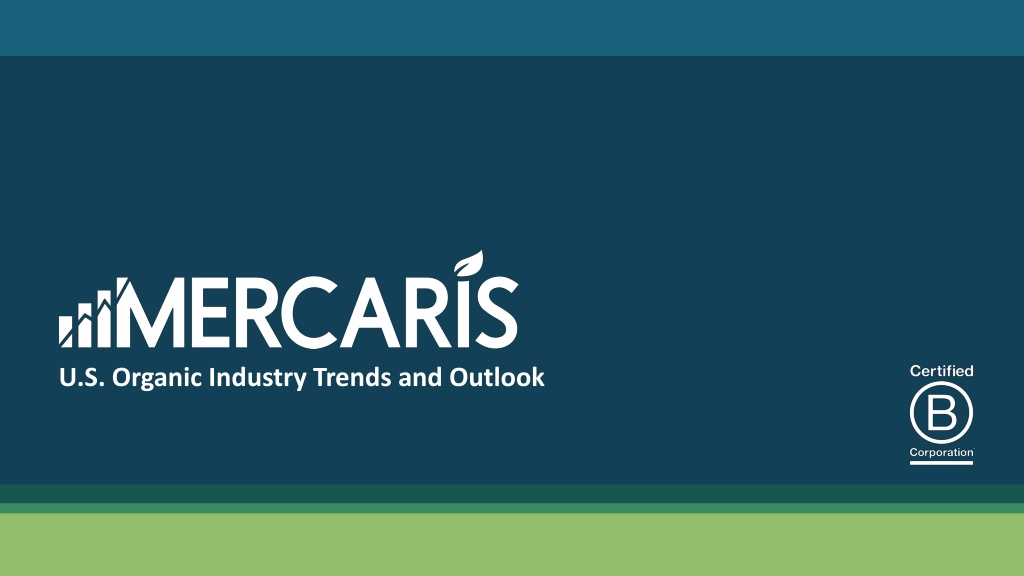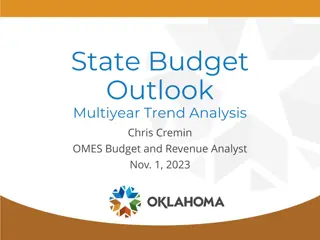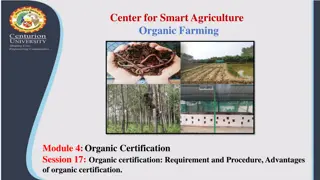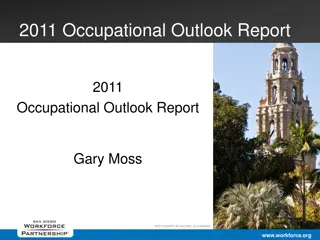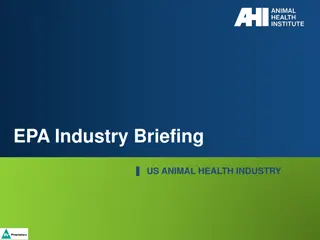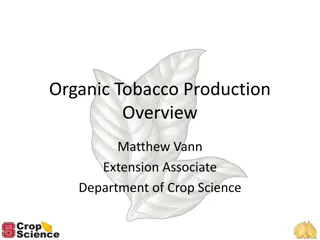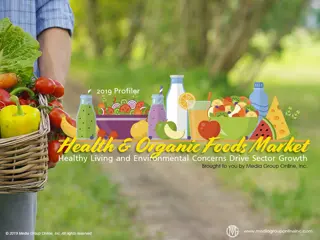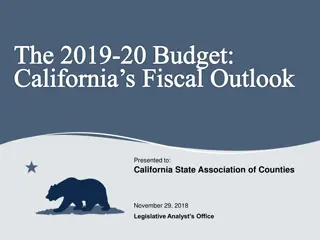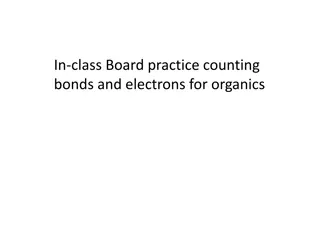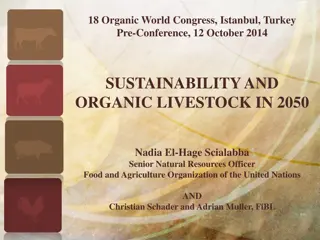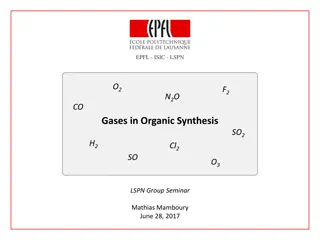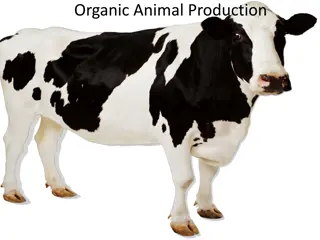Insights into U.S. Organic Industry Trends and Outlook
The U.S. organic industry is experiencing positive consumer demand growth, with organic food sales reaching $56 billion in 2020. Despite a decline in organic dairy sales, the overall organic acreage growth remains strong. The market faces challenges such as the impact of COVID-19, the need for product diversification in organic dairy, and threats posed by drought conditions in key Western states. Additionally, shifts in organic soybean imports and wheat production due to global supply chain challenges are affecting the market dynamics. Overall, the U.S. organic industry shows promising growth opportunities but also some areas of concern that need to be addressed for sustainable growth.
Download Presentation

Please find below an Image/Link to download the presentation.
The content on the website is provided AS IS for your information and personal use only. It may not be sold, licensed, or shared on other websites without obtaining consent from the author. Download presentation by click this link. If you encounter any issues during the download, it is possible that the publisher has removed the file from their server.
E N D
Presentation Transcript
U.S. Organic Consumer Demand Growth Remains Positive Organic food sales reach $56 billion over 2020 Organic food sales continue to outpace conventional Organic food sales 9% CAGR (2009-2019) Conventional food sales 3% CAGR (2009-2019) Record 2020 sales as consumers adjust to COVID
U.S. Organic Dairy In Decline 2017 2018 2019 2020 Organic Dairy Sales (Million U.S.$) Milk/Cream Yogurt Cheese Butter, Cottage Cheese, and Sour Cream Ice Cream Total % Change Y/Y Source: Mercaris 2021, Organic Trade Association $3,357 $1,217 $561 $3,394 $1,260 $572 $3,770 $1,310 $653 $421 $425 $492 $117 $5,673 -0.4% $119 $5,770 1.7% $142 $6,367 10.3% $5,694 2020 had 10% sales growth and 3% inventory decline 63% of 2020 growth came from fluid milk sales Through November 2021, U.S. organic fluid milk sales were down nearly 3% y/y Without product diversification, organic dairy sales are likely to struggle If organic dairy expands, it s likely to be due to lower feed prices
The long quiet comes to an end Price remarkably stable through 19/20 on steady supply of imports Indian organic soybean meal becomes 38% of U.S. supplies over 19/20 Organic Soybeans Turn Very Bullish January 2021: A new reality emerges Price gain 70% on looming Indian organic import reform, and global supply chain challenges Indian organic soybean meal import reach record levels ahead of trade restrictions 2021/22 Holds Bullish Market Risk Assuming organic soybean use reaches 2019/20 levels, the U.S. will need to imports another 16 million bu before Sep 2021 Where can it come from?
Drought Conditions Persist in Key Western States January 26th, 2021 January 25th, 2022
Overall U.S. Organic Corn Supply Remains Steady Altogether, 2020/21 organic corn supplies flat y/y at 58 million bushels 59 million bushels pushes us over the edge Total U.S. organic corn supply has remained remarkably stable around 58 million bushels annually Last time supplies went over 58 million bushels was 2018/19, leading to the bearish 2019/20 MY What happens the next time we break the 58 million bushel mark?
Organic Corn Prices Remain Firm, Despite growing Supplies Sep 2019-Sep 2020 Prices fall on $2.47/bu as harvest exceeds expectations Imports stall on lower U.S. prices Sep 2020-Sep 2021 Imports retract as U.S. market works through old-crop supplies and harvested new-crop, down 30% y/y Prices recover, gaining $2.28/bu Sep 2021 and beyond U.S organic corn harvest estimated at a record setting 49.5 million bu for 2021, up 9% y/y Imports are holding slightly higher since the start of 2021/22 Price remain bullish despite growing supplies (up $0.50/bu September through December 2021) Growers/purchasers hold supplies on uncertain U.S. production outlook Could we be building towards another 2019/20?
Could Feed Cost Hit the Brakes? 5-Year Average1 2020/21 MY $1,200 OSBM $1,300 OSBM $1,400 OSBM 2020/21 production costs jump 16% above 5-year average on higher organic soybean meal price Organic Feed Costs Feed-Grade Corn (U.S. $/bu)2 Soybean Meal (U.S. $/ST)3 Organic Turkey Feed (per-head slaughtered) $ $ 8.95 735 $ $ 7.96 1,067 $ $ 8.95 1,200 $ $ 8.95 1,300 $ $ 8.95 1,400 Organic Corn (14.3 lbs) Organic Soybean Meal (8.17 lbs) Total % Above 5-Year Average Organic Broiler Feed (per-head slaughtered) $ $ $ 2.29 3.00 5.29 $ $ $ 21% 2.03 4.36 6.39 $ $ $ 36% 2.29 4.90 7.19 $ $ $ 44% 2.29 5.31 7.60 $ $ $ 51% 2.29 5.72 8.01 What happens if $1,200/ST OSBM = 31% to 36% higher $1,300/ST OSBM = 38% to 44% higher $1,400/ST OSBM = 44% to 51% higher Organic Corn (7.44 lbs) Organic Soybean Meal (4.25 lbs) Total % Above 5-Year Average Organic Layers Feed (mature layer per-year) $ $ $ 1.19 1.56 2.75 $ $ $ 21% 1.06 2.27 3.32 $ $ $ 36% 1.19 2.55 3.74 $ $ $ 44% 1.19 2.76 3.95 $ $ $ 51% 1.19 2.98 4.16 Organic Corn (54.75 lbs) Organic Soybean Meal (22.81 lbs) Total % Above 5-Year Average Source: Mercaris 2021 1. Average calculated over 2015/16 though 2019/20 MY 2. Organic feed-grade corn delivered to U.S. Corn Belt elevators 3. High-protein organic soybean meal FOB U.S. crushing facility $ $ $ 8.75 8.38 17.13 $ $ $ 16% 7.78 12.17 19.95 $ $ $ 31% 8.75 13.69 22.44 $ $ $ 38% 8.75 14.83 23.58 $ $ $ 44% 8.75 15.97 24.72 How sustainable is production growth at +30% higher feed costs?
What if Organic Feed Demand Grows Slows 2021/221 2016/17 2020/21 6-Year CAGR Grain Feed Demand (1,000 GCAU) Organic dairy remains the largest grain consumer But not a source of growth, and actually in retraction Milk Cows & Heifers Beef Cows Cattle on Grass Cattle Total 531 2 5 538 549 2 9 561 544 3 10 556 0.5% 2.3% 16.3% 0.7% Organic poultry expansion has carried the market 4.9% annual growth As a group broilers, turkeys, and layers account for 56% of total demand over 2020/21 Broilers Turkeys Layers Poultry Total Total GCAU Corn Feed Use 214 34 336 584 1,126 225 64 441 730 1,303 227 69 445 741 1,311 1.2% 14.9% 5.8% 4.9% 3.1% Flat dairy and growing poultry put feed demand growth at 3.1% annually Flat dairy and growing poultry put GCAU growth at 3.1% Organic corn growth a bit faster at 4.2% Organic corn production growing at 4.5% Grain Feed Use (1,000 bu) Domestic Production Imports2 Feed Use (bu/GCAU)1 Source: Mercaris 2021 37,666 16,620 21,046 44.16 45,308 33,854 11,454 43.92 46,176 36,442 9,734 44.43 4.2% 17.0% -14.3% 0.1% Note: Values represent September August MY 1. Includes corn silage converted to grain corn equivalent value 2. Includes whole and cracked corn imports
For more information, please contact: Ryan Koory Ryan.Koory@Mercaris.com 573-644-2004
